Geohydrology of a Reference Mediterranean Catchment (Cilento UNESCO Geopark, Southern Italy)
Abstract
1. Introduction
2. Materials and Methods
2.1. The Study Area
2.2. Hydro-Chemical Dataset
2.3. Geomorphometric Analysis
2.4. Hysteretic Analysis
3. Results
3.1. Geomorphometric Analysis Aesults
3.2. Connection between the Hydro-Chemical Relations and Hysteretic Loops
3.3. Hysteretic Index Results
4. Discussion
5. Conclusions
Author Contributions
Funding
Acknowledgments
Conflicts of Interest
References
- Aich, V.; Zimmermann, A.; Elsenbeer, H. Quantification and interpretation of suspended-sediment discharge hysteresis patterns: How much data do we need? CATENA 2014, 122, 120–129. [Google Scholar] [CrossRef]
- Bouleau, G.; Pont, D. Did you say reference conditions? Ecological and socio-economic perspectives on the European Water Framework Directive. Environ. Sci. Policy 2015, 47, 32–41. [Google Scholar] [CrossRef]
- Hopp, L.; Harman, C.; Desilets, S.L.E.; Graham, C.B.; McDonnell, J.J.; Troch, P.A. Hillslope hydrology under glass: Confronting fundamental questions of soil-water-biota co-evolution at Biosphere 2. Hydrol. Earth Syst. Sci. 2009, 13, 2105–2118. [Google Scholar] [CrossRef]
- Guida, D.; Cuomo, A.; Palmieri, V. Using object-based geomorphometry for hydro-geomorphological analysis in a Mediterranean research catchment. Hydrol. Earth Syst. Sci. 2016, 20, 3493–3509. [Google Scholar] [CrossRef]
- Bovolin, V.; Cuomo, A.; Guida, D. Monitoring Activity at the Middle Bussento Karst System (Cilento Geopark, Southern Italy). In Engineering Geology for Society and Territory; Springer: Cham, Switzerland, 2016; Volume 3, pp. 275–279. [Google Scholar]
- Guida, D.; Longobardi, A.; Villani, P.; Cuomo, A. Hydrological modelling for river basin management in a highly hydro-geological conditioned environment. WIT Trans. Ecol. Environ. 2006, 10, 283–292. [Google Scholar] [CrossRef]
- Guida, D.; Cuomo, A. Using discharge-electrical conductivity relationship in a Mediterranean catchment: The T. Ciciriello in the Cilento, Vallo Diano and Alburni European Geopark (Southern Italy). In Engineering Geology for Society and Territory; Springer: Cham, Switzerland, 2015; pp. 201–205. [Google Scholar]
- Cuomo, A.; Guida, D. Using hydro-chemograph analyses to reveal runoff generation processes in a Mediterranean catchment. Hydrol. Process. 2016, 30, 4462–4476. [Google Scholar] [CrossRef]
- Guida, D. The contribution of the geo-scientific community to risk, resource and chance management, education and dissemination in the Cilento, Vallo Diano and Alburni - Geopark (Southern Italy). In Proceedings of the 12th European Geoparks Conference National Park of Cilento, Vallo di Diano and Alburni Geopark, Italy, 4–6 September 2013; pp. 30–32. [Google Scholar]
- Longobardi, A.; Guida, D.; Cuomo, A.; Villani, P. At which time step do we need to monitor the stream hydro-chemistry properties for low flow characterization? Rend. Online Della Soc. Geol. Ital. 2015, 35, 3. [Google Scholar] [CrossRef]
- Longobardi, A.; Villani, P.; Guida, D.; Cuomo, A. Hydro-geo-chemical streamflow analysis as a support for digital hydrograph filtering in a small, rainfall dominated, sandstone watershed. J. Hydrol. 2016, 539, 177–187. [Google Scholar] [CrossRef]
- Longobardi, A.; Villani, P.; Guida, D.; Cuomo, A. Regression Approaches for Hydrograph Separation: Implications for the Use of Discontinuous Electrical Conductivity Data. Water 2018, 10, 1235. [Google Scholar] [CrossRef]
- Betson, R.P. What is watershed runoff? J. Geophys. Res. 1964, 69, 1541–1551. [Google Scholar] [CrossRef]
- Ladouche, B.; Probst, A.; Viville, D.; Idir, S.; BaqueÂ, D.; Loubet, M.; Probst, J.-L.; Bariac, T. Hydrograph separation using isotopic, chemical and hydrological approaches (Strengbach catchment, France). J. Hydrol. 2001, 242, 255–274. [Google Scholar] [CrossRef]
- Klaus, J.; McDonnell, J.J. Reviewe paper: Hydrograph separation using stable isotopes: Review and evaluation. J. Hydrol. 2013, 505, 47–64. [Google Scholar] [CrossRef]
- Pellerin, B.; Wollheim, W.; Feng, X.; Charles, J. The application of electrical conductivity as a tracer for hydrograph separation in urban catchments. Hydrol. Process. 2008, 22, 1810–1818. [Google Scholar] [CrossRef]
- Stewart, M.; Cimino, J.; Ross, M. Calibration of Base Flow Separation Methods with Streamflow Conductivity. Ground Water 2007, 45, 17–27. [Google Scholar] [CrossRef]
- Lott, D.A.; Stewart, M.T. A Power Function Method for Estimating BaseFlow. Groundwater 2013, 51, 442–451. [Google Scholar]
- Zhang, R.L.Q.; Chow, T.L.L.S.; Danielescu, S. Baseflow separation in a small watershed in New Brunswick Canada, using a recursive digital filter calibrated with the conductivity mass balance method. Hydrol. Process. 2013, 27, 2659–2665. [Google Scholar] [CrossRef]
- Genereux, D. Quantifying uncertainty in tracer-based hydrograph separations. Water Resour. Res. 1998, 34, 915–919. [Google Scholar] [CrossRef]
- Sklash, M.; Farvolden, R. Role of groundwater in storm runoff. J. Hydrol. 1979, 43, 45–65. [Google Scholar] [CrossRef]
- Penna, D.; van Meervelt, H.J.; Oliviero, O.; Zuecco, G.; Assendelft, R.S.; Dalla Fontana, G.; Borga, M. Seasonal changes in runoff generation in a small forested mountain catchment. Hydrol. Process. 2014, 29, 2027–2042. [Google Scholar] [CrossRef]
- Montgomery, J.L.; Harmon, T.; Haas, C.N.; Hooper, R.; Clesceri, N.L.; Graham, W.; Kaiser, W.; Sanderson, A.; Minsker, B.; Schnoor, J.; et al. The WATERS Network: An Integrated Environmental Observatory Network for Water Research. Environ. Sci. Technol. 2007, 41, 6642–6647. [Google Scholar] [CrossRef]
- Bowes, M.J.; Jarvie, H.P.; Halliday, S.J.; Skeffington, R.A.; Wade, A.J.; Loewenthal, M.; Gozzard, E.; Newman, J.R.; Palmer-Felgate, E.J. Characterising phosphorus and nitrate inputs to a rural river using high-frequency concentration-flow relationships. Sci. Total Environ. 2015, 511, 608–620. [Google Scholar] [CrossRef]
- Zuecco, G.; Penna, D.; Borga, M.; van Meerveld, H.J. A versatile index to characterize hysteresis between hydrological variables at the runoff event timescale. Hydrol. Process. 2016, 30, 1449–1466. [Google Scholar] [CrossRef]
- Murphy, J.C.; Hornberger, G.M.; Liddle, R.G. Concentration–discharge relationships in the coal mined region of the New River basin and Indian Fork sub-basin, Tennessee, USA. Hydrol. Process. 2014, 28, 718–728. [Google Scholar] [CrossRef]
- Shanley, J.B.; Sebestyen, S.D.; McDonnell, J.J.; McGlynn, B.L.; Dunne, T. Water’s Way at Sleepers River watershed – revisiting flow generation in a post-glacial landscape, Vermont USA. Hydrol. Process. 2015, 29, 3447–3459. [Google Scholar] [CrossRef]
- McGuire, K.J.; McDonnell, J.J. Hydrological connectivity of hillslopes and streams: Characteristic time scales and nonlinearities. Water Resour. Res. 2010, 46, 1–17. [Google Scholar] [CrossRef]
- Fovet, O.; Ruiz, L.; Hrachowitz, M.; Faucheux, M.; Gascuel-Odoux, C. Hydrological hysteresis and its value for assessing process consistency in catchment conceptual models. Hydrol. Earth Syst. Sci. 2015, 19, 105–123. [Google Scholar] [CrossRef]
- Zhang, Q.; Manzoni, S.; Katul, G.; Porporato, A.; Yang, D. The hysteretic evapotranspiration—Vapor pressure deficit relation. J. Geophys. Res. Biogeosci. 2014, 119, 125–140. [Google Scholar] [CrossRef]
- Zheng, H.; Wang, Q.; Zhu, X.; Li, Y.; Yu, G. Hysteresis Responses of Evapotranspiration to Meteorological Factors at a Diel Timescale: Patterns and Causes. PLoS ONE 2014, 9, e98857. [Google Scholar] [CrossRef]
- Allocca, V.; Manna, F.; De Vita, P. Estimating annual groundwater recharge coefficient for karst aquifers of the southern Apennines (Italy). Hydrol. Earth Syst. Sci. 2014, 18, 803–817. [Google Scholar] [CrossRef]
- Celico, P.; De Vita, P.; Aloia, A. Caratterizzazione idrogeologica della Formazione di Monte Sacro (Cilento- Campania meridionale). Geologia Applicata e Idrogeologia 1993, XXVIII, 243–252. [Google Scholar]
- Celico, P. Prospezioni Idrogeologiche; Liguori editore: Napoli, Italy, 1986. [Google Scholar]
- Bonardi, G.; Amore, F.O.; Ciampo, G.; De Capoa, P.; Miconnet, P.; Perrone, V. Il complesso liguride Auct.: Stato delle conoscenze e problemi sualla sua evoluzione Pre-Appenninica ed i suoi rapporti con l’arco calabro. Mem. Soc. Geol. Ital. 1988, 41, 17–35. [Google Scholar]
- Guida, D.; Guida, M.; Luise, D.; Salzano, G.; Vallario, A. Idrogeologia del Cilento (Campania). Geol. Rom 1980, 19, 349–369. [Google Scholar]
- Cascini, L.; Cuomo, S.; Guida, D. Typical source areas of May 1998 flow-like mass movements in the Campania region, Southern Italy. Eng. Geol. 2008, 96, 107–125. [Google Scholar] [CrossRef]
- Cuomo, A. Il contributo Della Idro-Geomorfologia Nella Valutazione Delle Piene in Campania; University of Salerno: Fisciano, Italy, 2012. [Google Scholar]
- Hewlett, J.D.; Hibbert, A.R. Factors affecting the response of small forested watersheds to precipitation in humid regions. In Proceedings of the International symposium on Forest Hydrology, New York, NY, USA, 29 August–10 September 1965; pp. 275–290. [Google Scholar]
- Sidle, R.C.; Tsuboyama, Y.; Noguchi, S.; Hosoda, I.; Motohisa, F.; Shimuizu, T. Stormflow generation in steep forested headwater: A linked hydrogeomorphic paradigm. Hydrol. Process. 2000, 14, 369–385. [Google Scholar] [CrossRef]
- Burrough, P.A. Principles of geographical information systems for land resources assessment. Geocarto Int. 1986, 1, 54. [Google Scholar] [CrossRef]
- Horton, R. Drainage Basin Characteristics. Trans. Am. Geophys. Union 1932, 13, 11. [Google Scholar] [CrossRef]
- Leopold, L.B.; Wolman, M.G.; Miller, J.P. Fluvial processes in geomorphology: San Francisco; W.H. Freeman and Co: San Francisco, CA, USA, 1964. [Google Scholar]
- Moore, I.D.; Gessler, P.; Nielsen, G.A.E.; Peterson, G. Soil Attribute Prediction Using Terrain Analysis. Soil Sci. Soc. Am. J.—SSSAJ 1993, 57, 443–452. [Google Scholar] [CrossRef]
- Schmidt, F.; Persson, A. Comparison of DEM Data Capture and Topographic Wetness Indices. Precis. Agric. 2003, 4, 179–192. [Google Scholar] [CrossRef]
- Gallant, J.C.; Wilson, J.P. Primary topographic attributes. In Terrain Analysis: Principles and Applications; Gallant, J.C., Wilson, J.P., Eds.; Wiley: New York, NY, USA, 2000; p. 34. [Google Scholar]
- Strahler, A. Quantitative Geomorphology of Drainage Basins and Channel Networks. In Handbook of Applied Hydrology; Chow, V., Ed.; McGraw Hill: New York, NY, USA, 1964; p. 36. [Google Scholar]
- Liu, F.; Conklin, M.H.; Shaw, G.D. Insights into hydrologic and hydrochemical processes based on concentration-discharge and end-member mixing analyses in the mid-Merced River Basin, Sierra Nevada, California. Water Resour. Res. 2017, 53, 832–850. [Google Scholar] [CrossRef]
- Lloyd, C.E.M.; Freer, J.E.; Johnes, P.J.; Collins, A.L. Using hysteresis analysis of high-resolution water quality monitoring data, including uncertainty, to infer controls on nutrient and sediment transfer in catchments. Sci. Total Environ. 2016, 543, 388–404. [Google Scholar] [CrossRef]
- Chang, M. Forest Hydrology: An Introduction to Water and Forests, 2nd ed.; Taylor & Francis: Abingdon, UK, 2006. [Google Scholar]
- Langlois, J.; Johnson, D.; Mehuys, G. Suspended sediment dynamics associated with snowmelt runoff in a small mountain stream of Lake Tahoe (Nevada). Hydrol. Process. 2005, 19, 3569–3580. [Google Scholar] [CrossRef]
- Lawler, D.M.; Petts, G.E.; Foster, I.D.L.; Harper, S. Turbidity dynamics during spring storm events in an urban headwater river system: The Upper Tame, West Midlands, UK. Sci. Total. Environ. 2006, 360, 109. [Google Scholar] [CrossRef]
- Lloyd, C.E.M.; Freer, J.E.; Johnes, P.J.; Collins, A.L. Technical Note: Testing an improved index for analysing storm discharge–concentration hysteresis. Hydrol. Earth Syst. Sci. 2016, 20, 625–632. [Google Scholar] [CrossRef]
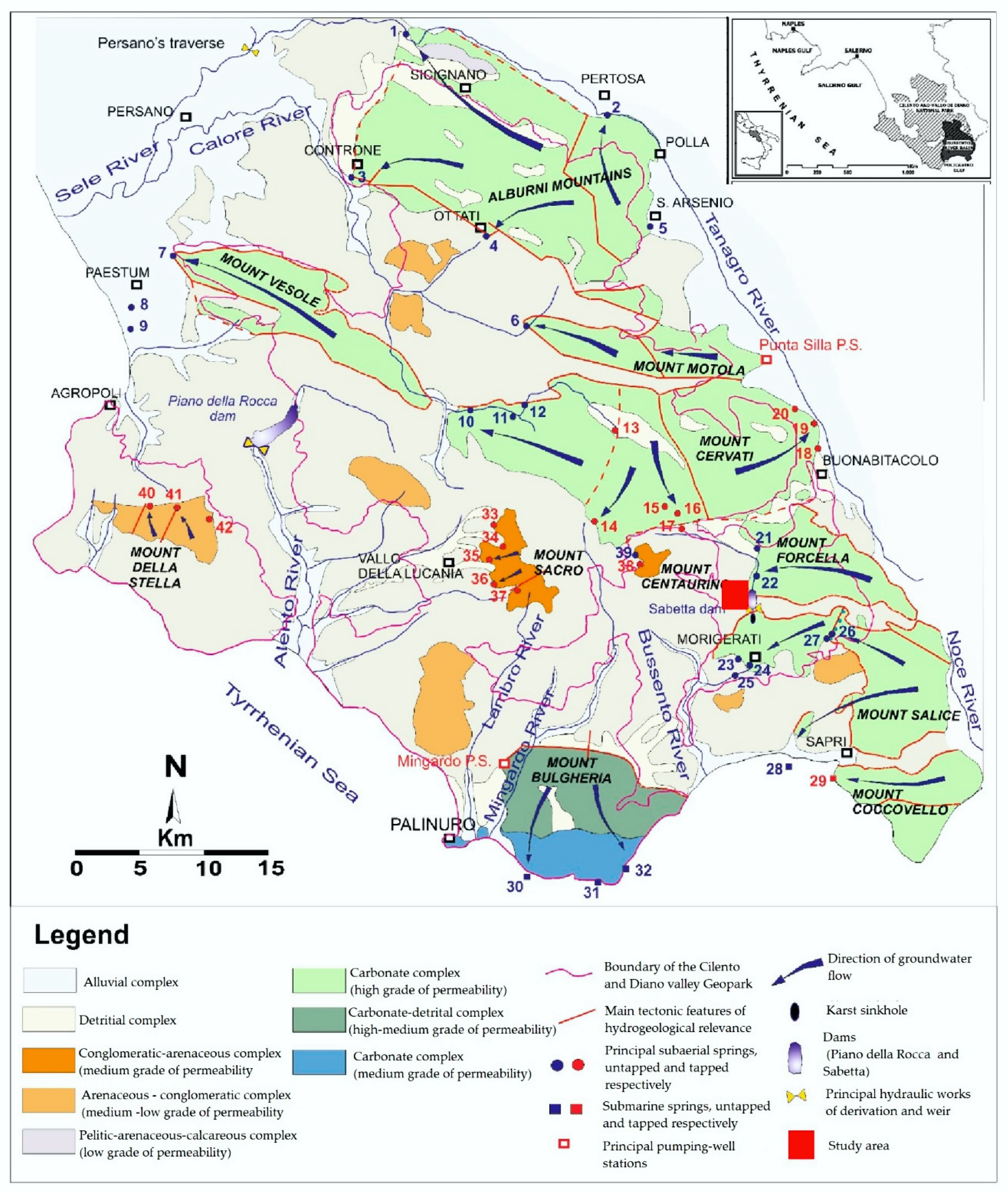
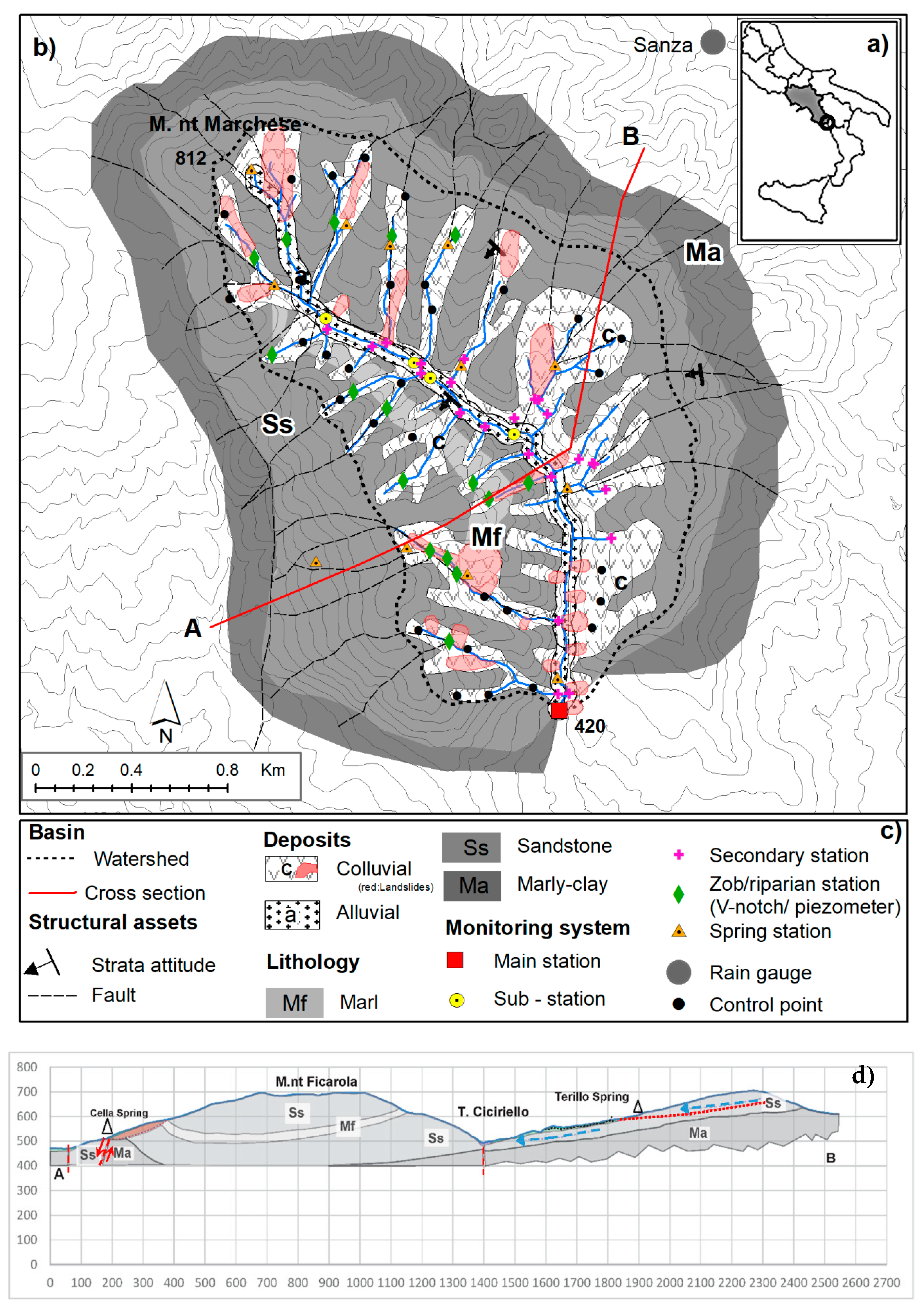
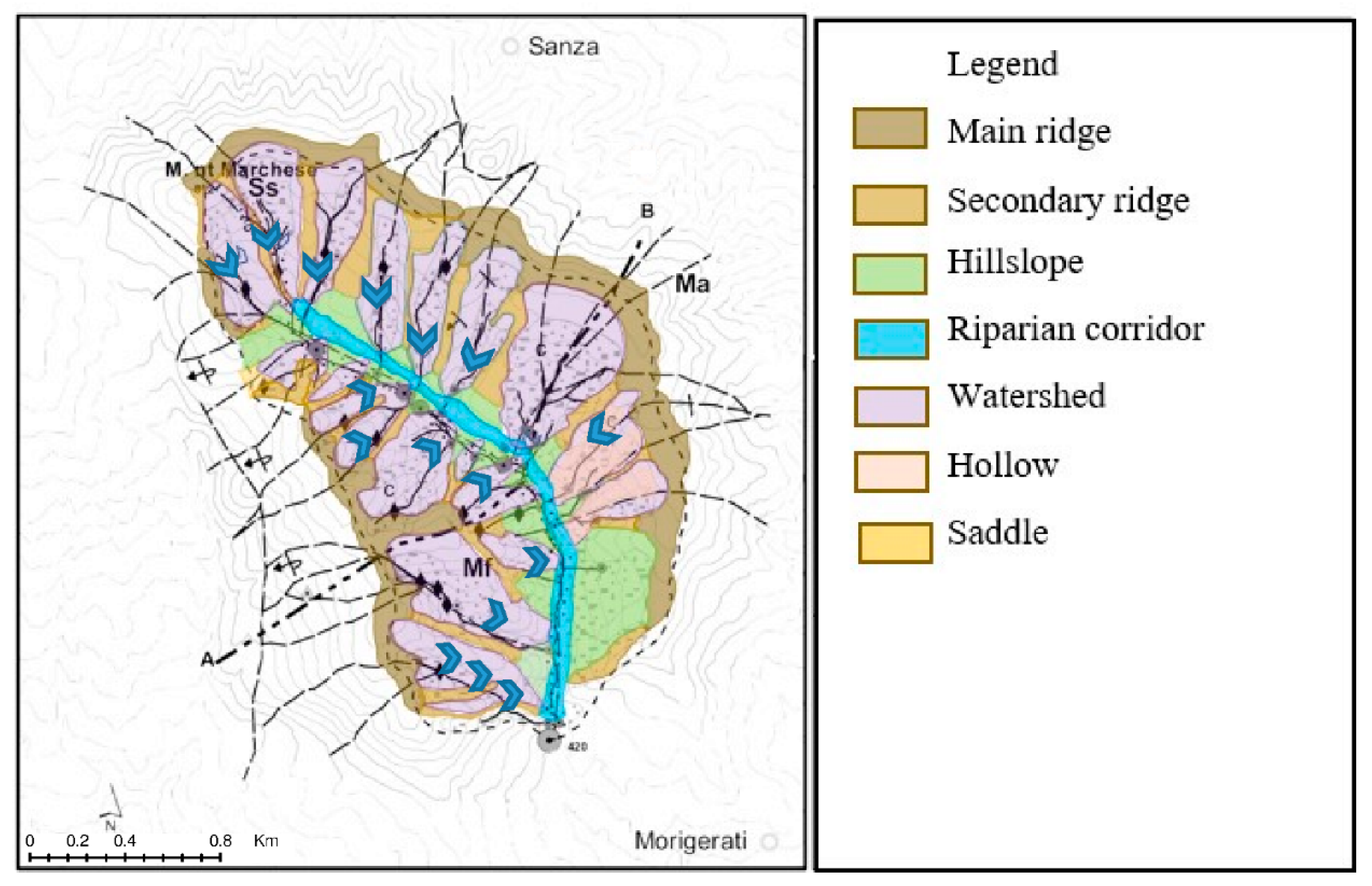

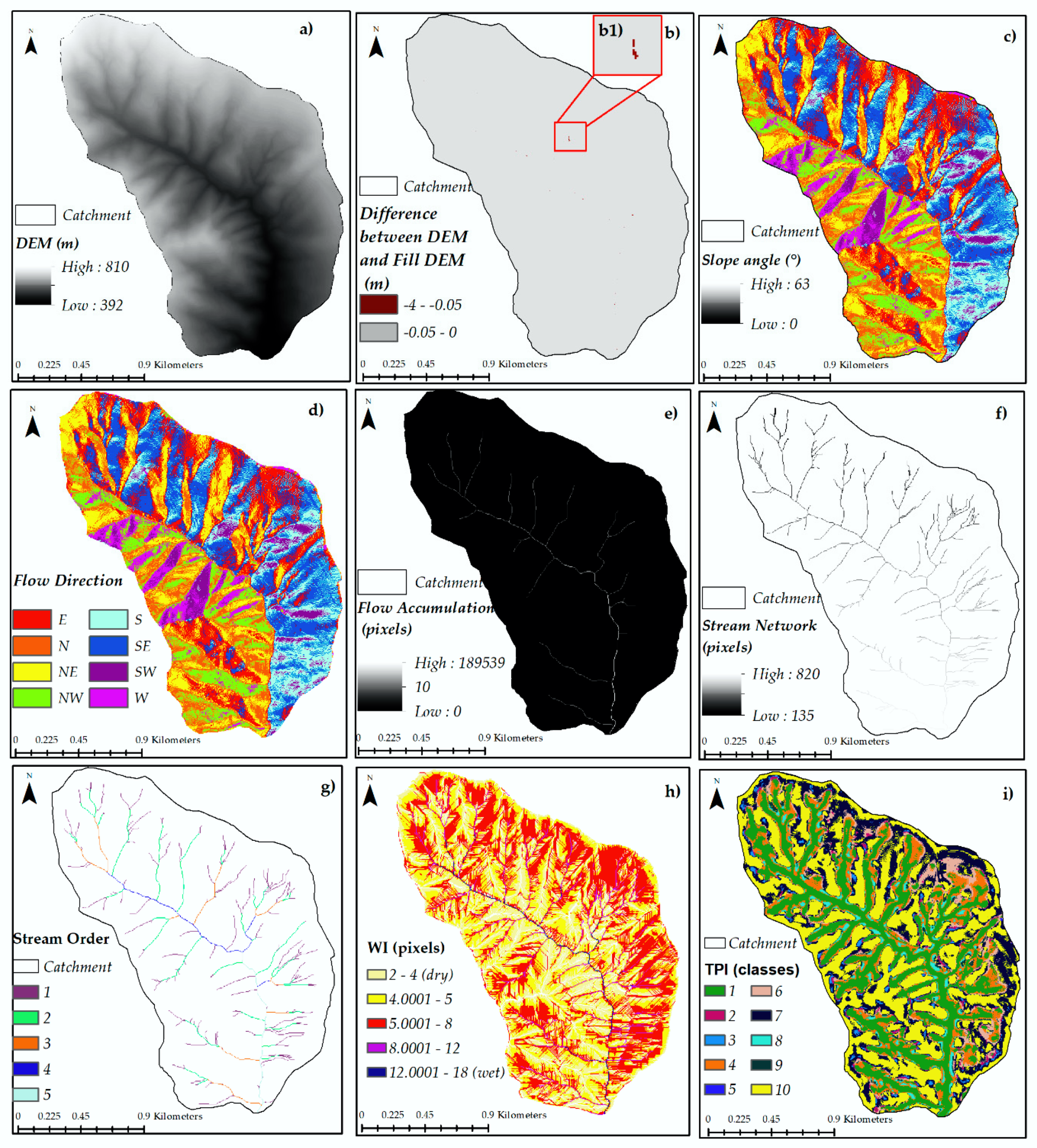
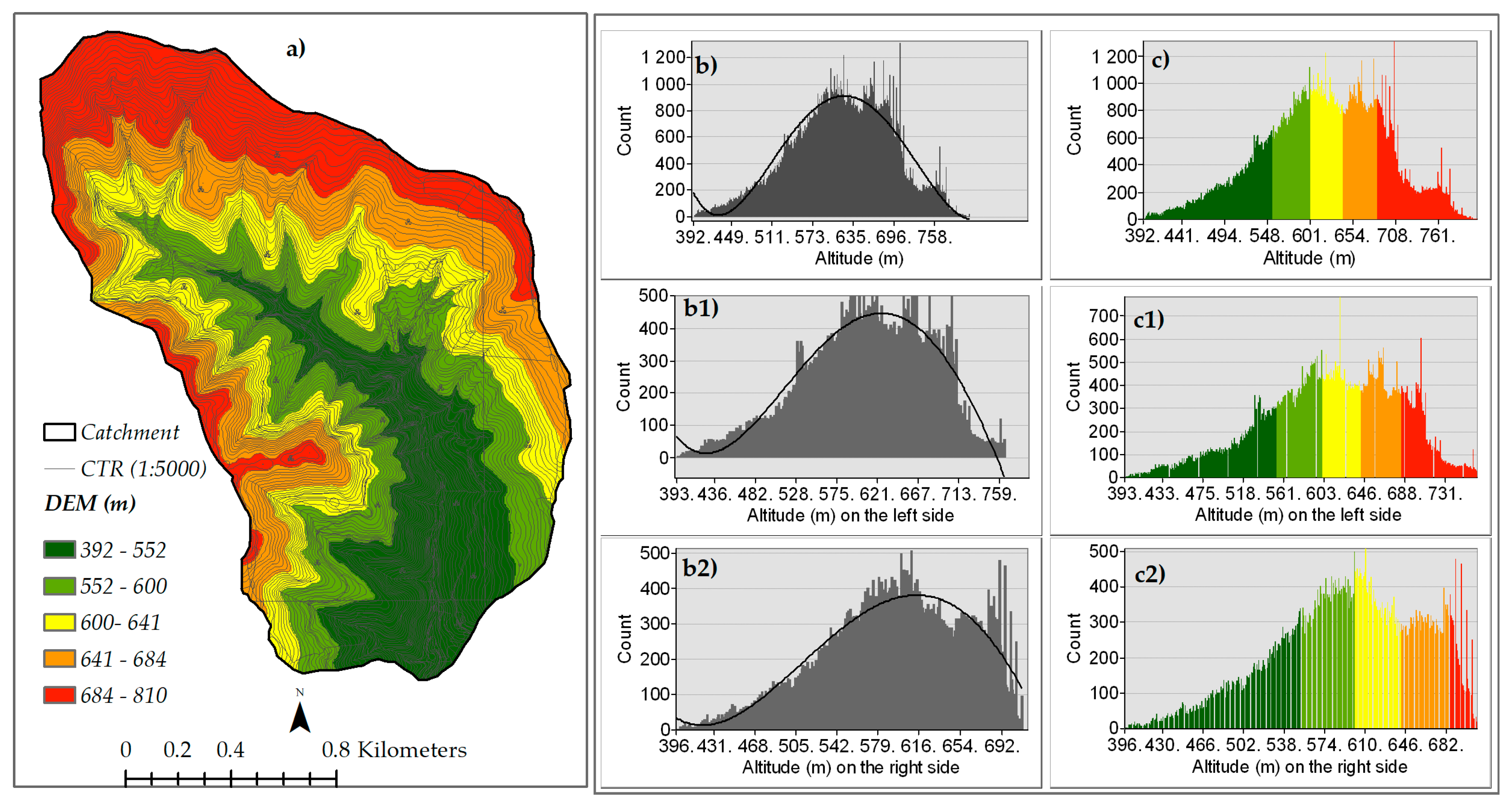
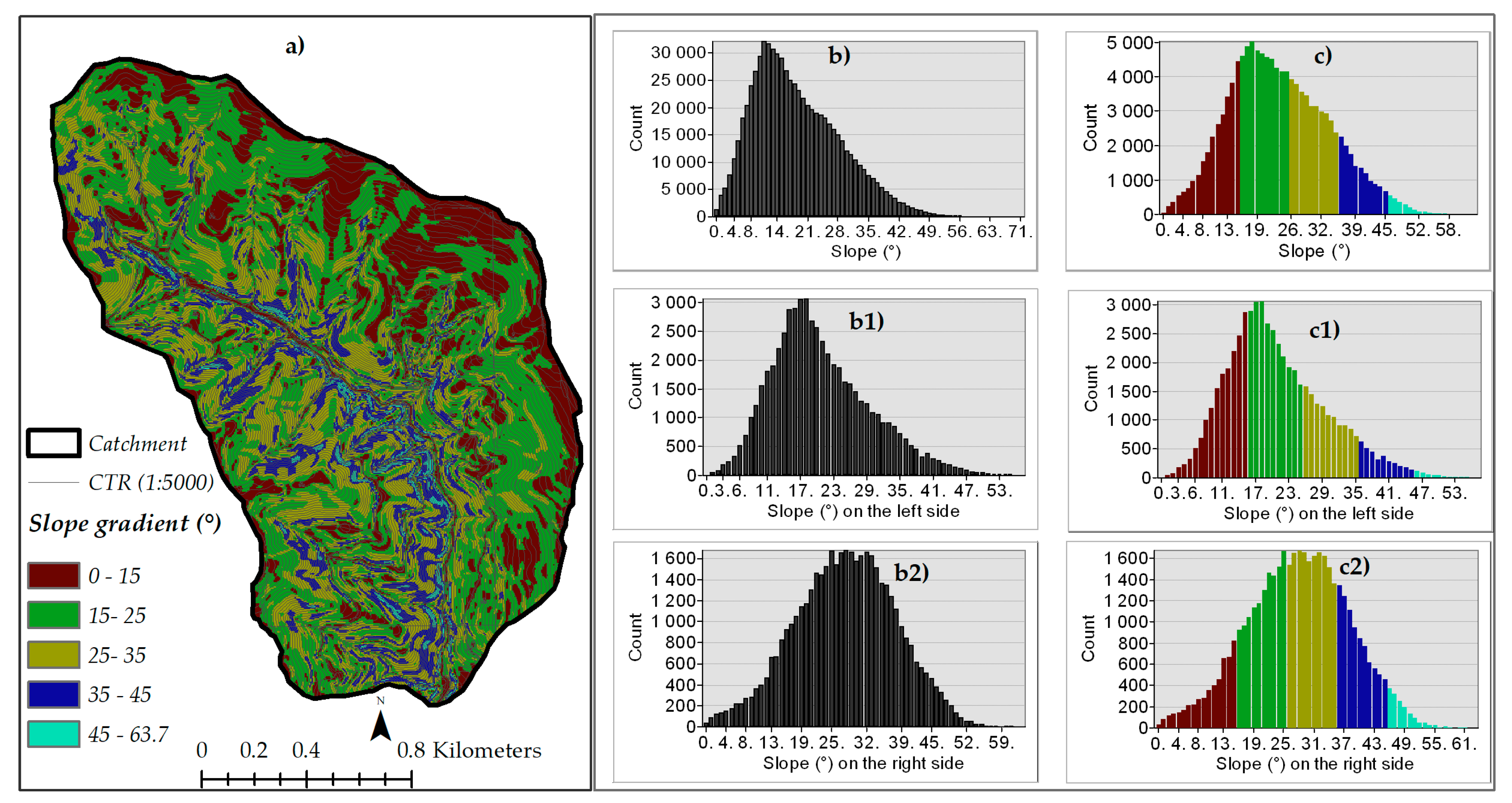
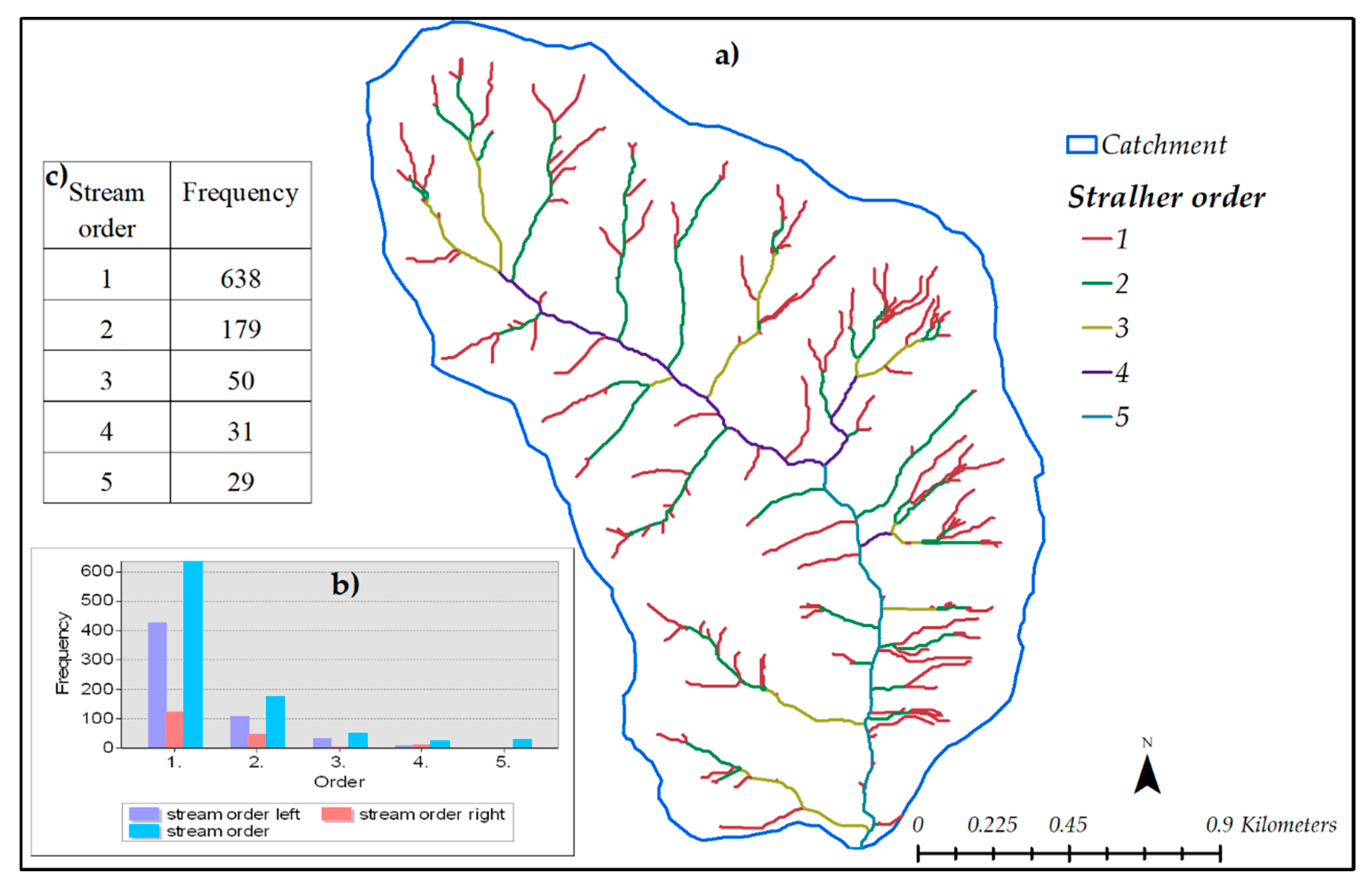
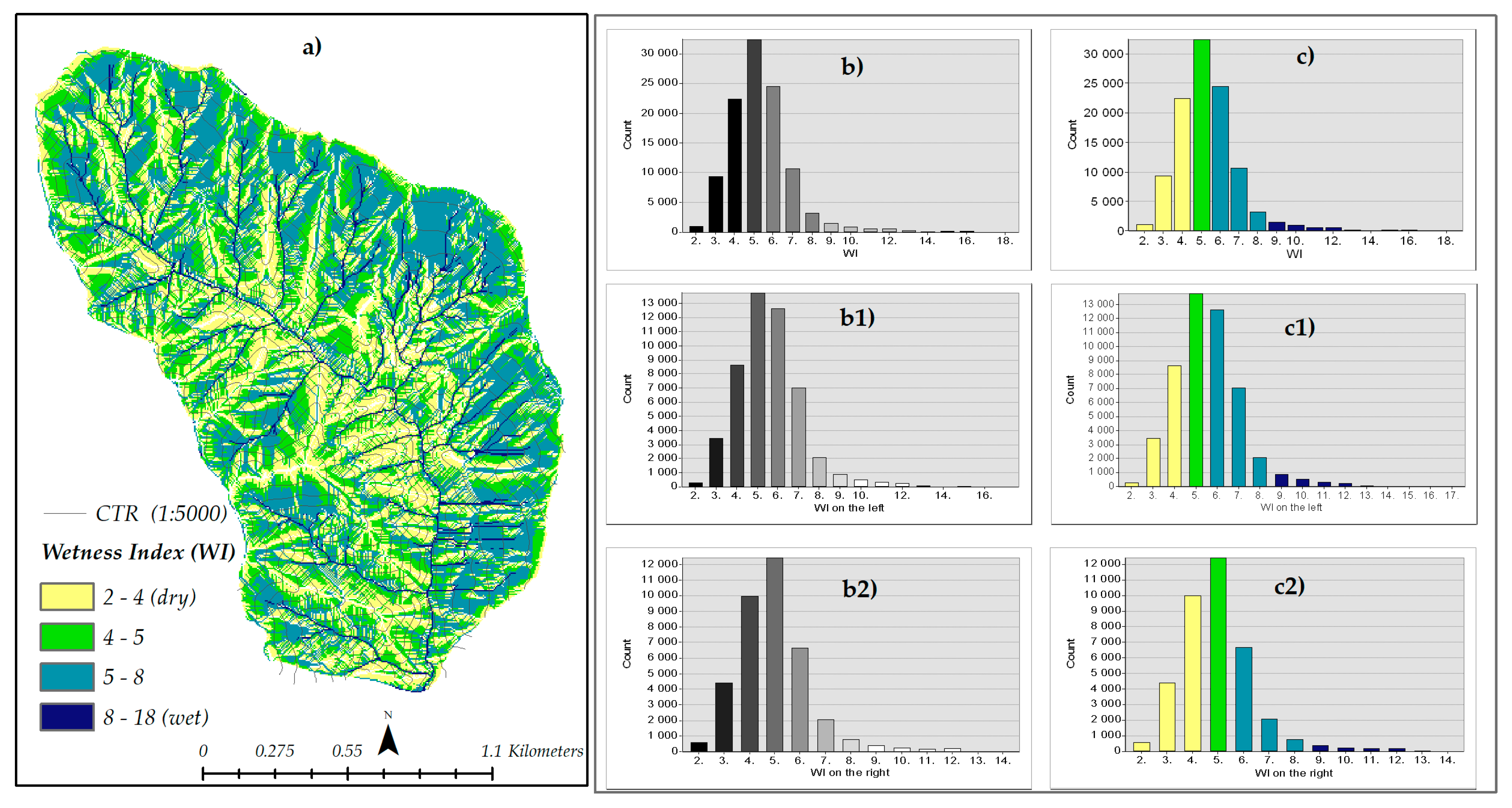
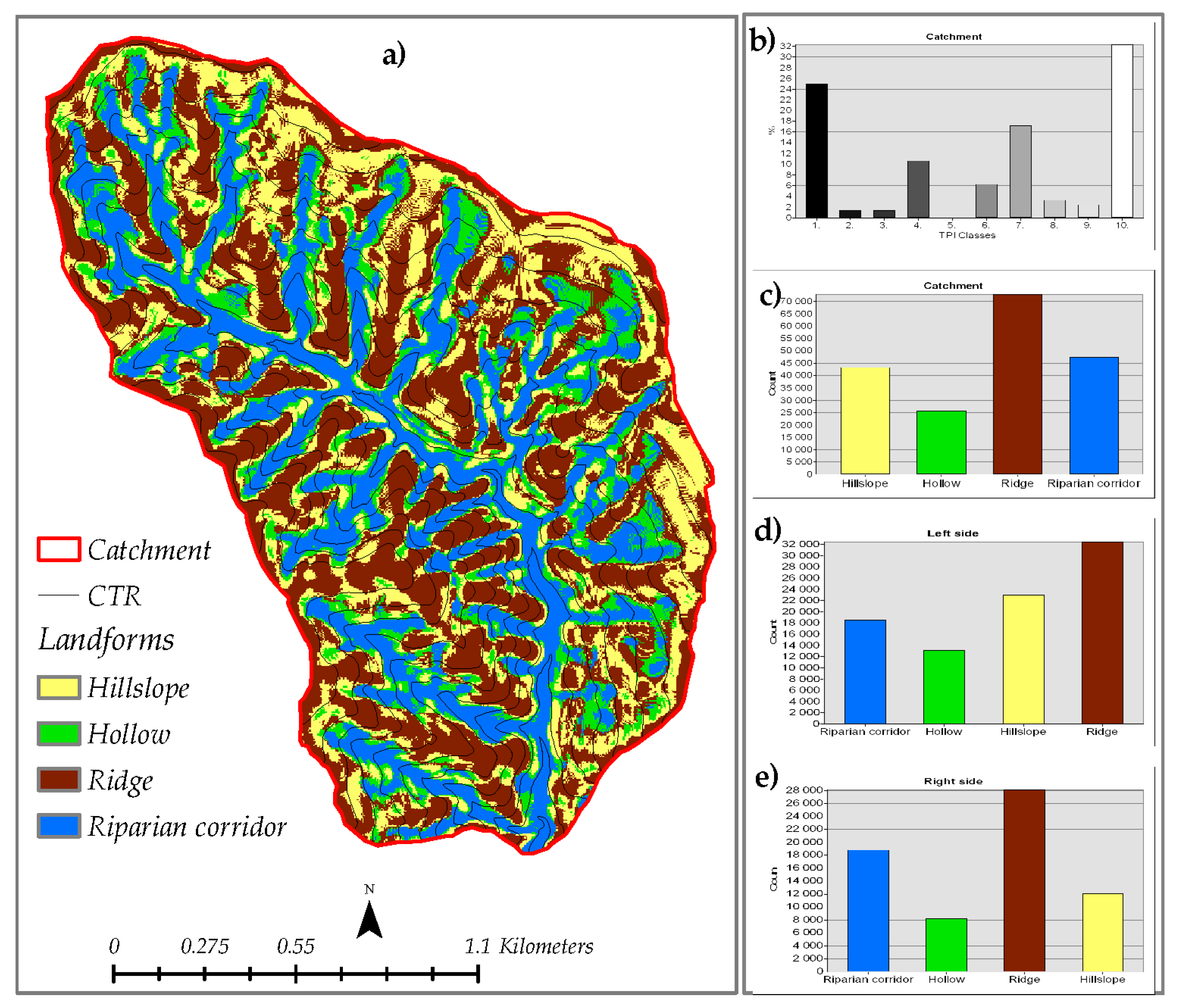

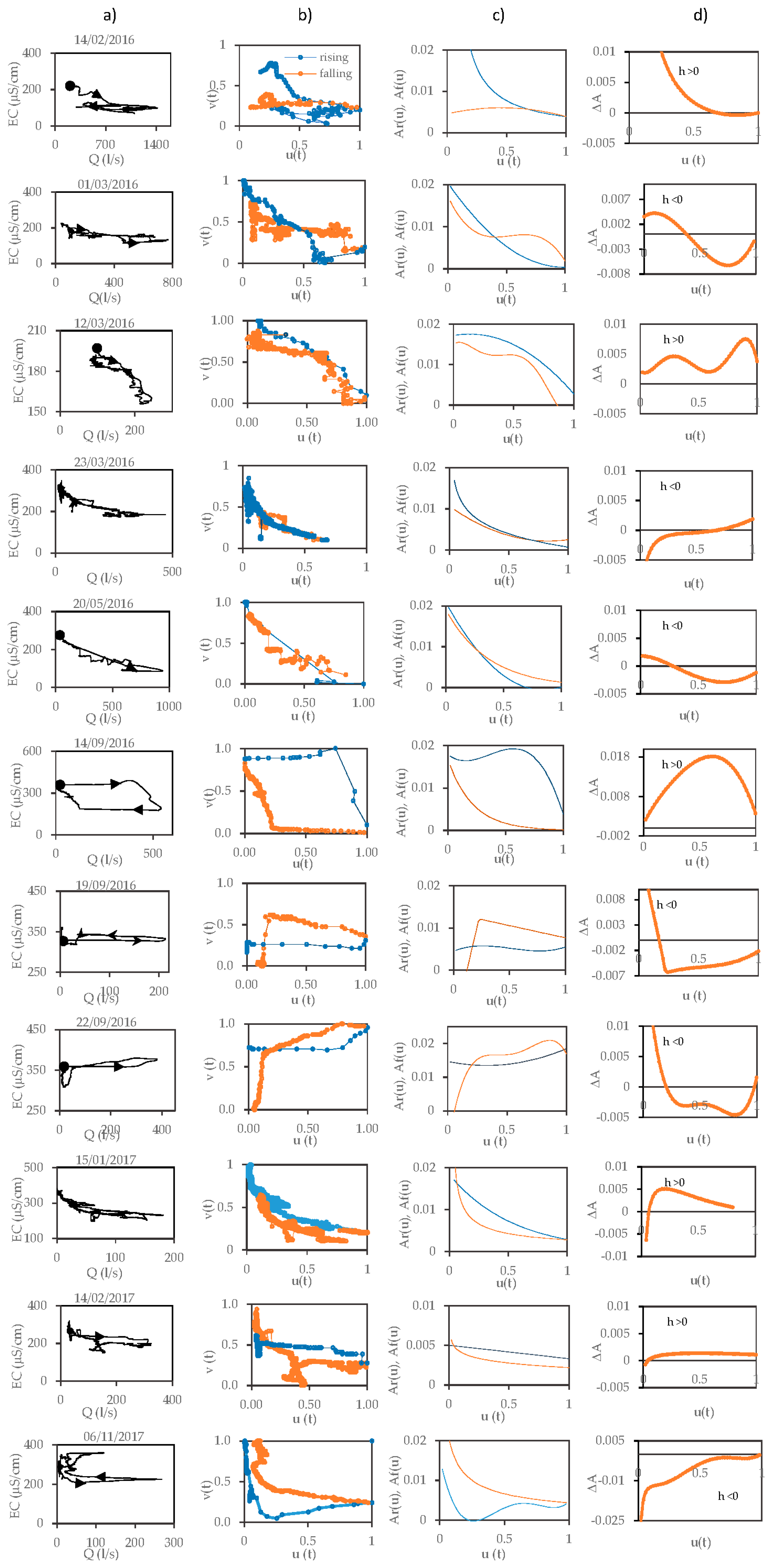
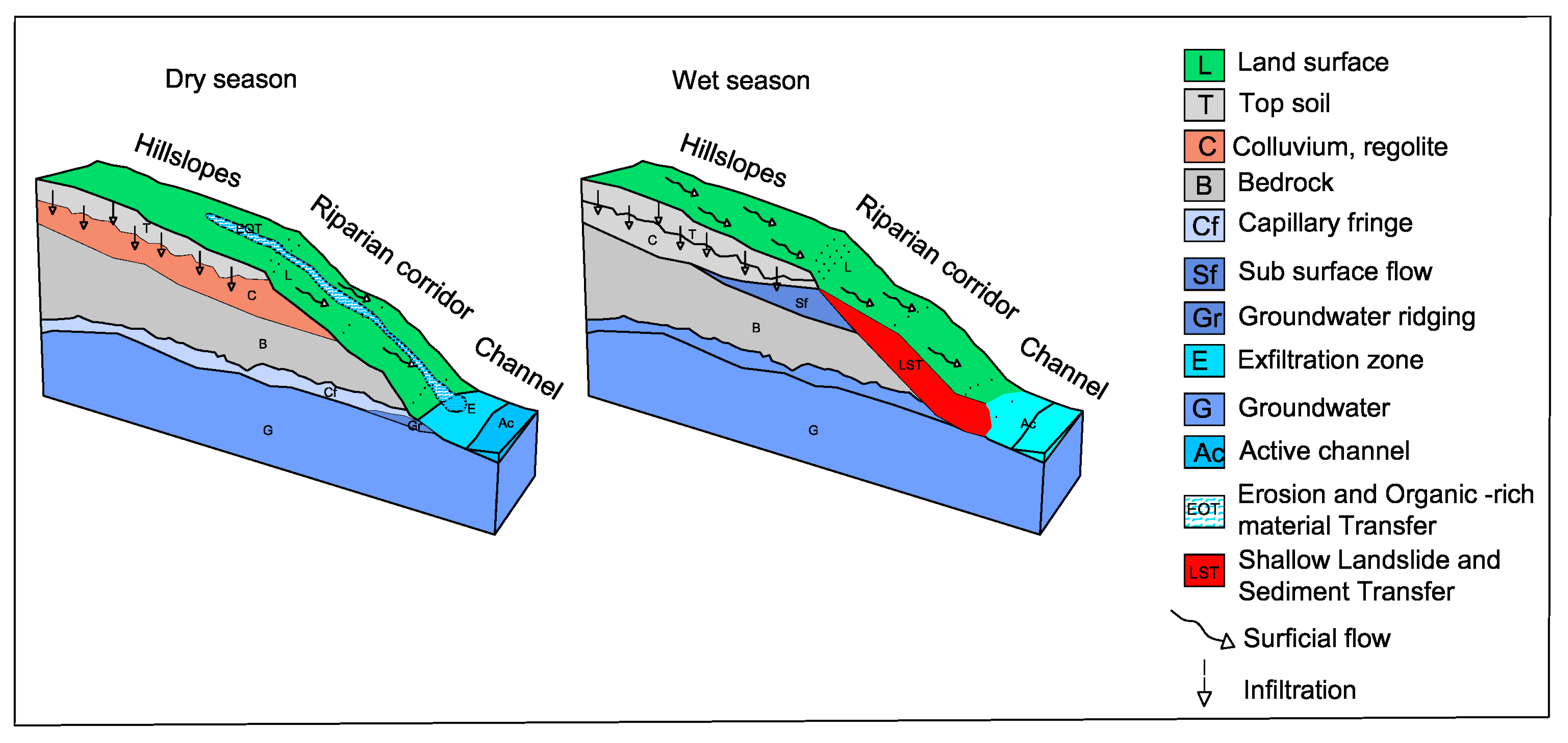
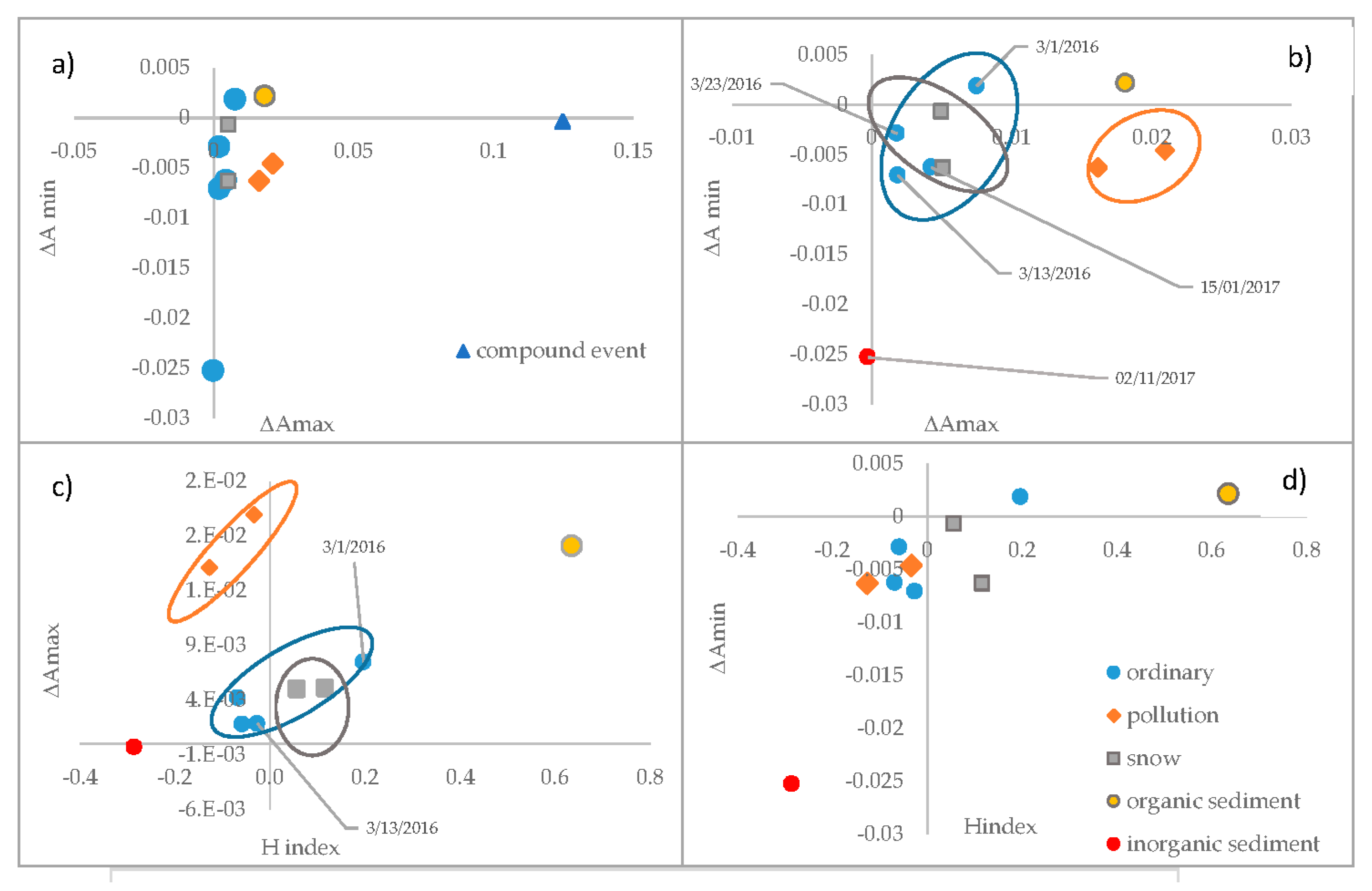
| Landform, Component or Element | Hydro-Geomorphotype (HGT in [38]) | Hydro-Geomorphological Behaviour | Station Type for Sampled Water Sources | Temporal Resolution | EC Range (μS/cm) |
|---|---|---|---|---|---|
| Upland, summit, peak, crest | Ridge | Groundwater recharge on bare bedrock and dominant excess infiltration runoff after storm | -Springs -Control points | -Monthly -After heaviest storms | 250–300 <100 |
| Shoulder, side slope | Nose | Shallow soil, groundwater recharge area, prevalently excess infiltration runoff | -Spring -Control points | -Monthly -After heaviest storms | 250–300 <100 |
| Scarps, back-slope, foot-slope, wash-slope, talus | Hillslope | Debris, deep soil, shallow aquifer, excess saturation excess and sub-surficial runoff | -Piezometers -Control points | -Weekly -After heaviest storms | 120–180 |
| Glen, swallet, scar | Hollow | Deep soil, shallow aquifer, prevalently excess saturation, delayed runoff production | Hollow | Monthly | 120–180 |
| V-shaped stream, gully, bank, stream bed | Riparian corridor | Shallow soil, groundwater discharge, prevalently sub-surface, delayed return flow and groundwater ridging | Piezometers | Weekly-continuously | 200–220 |
| Station Type for Sampled Water Sources | Number | Collected Parameters | Temporal Resolution | Mode | ||
|---|---|---|---|---|---|---|
| Q | D | EC | ||||
| Main | 1 | x | x | x | Daily/Sub-hourly | Automatic |
| Sub-stations | 4 | x | x | Weekly | Manual | |
| Secondary | 23 | x | x | Weekly | Manual | |
| Springs | 13 | x | x | Monthly | Manual | |
| Hollow | 16 | x | x | Montly | Manual | |
| Weir V-notch 90° | 16 | x | x | Daily | Semi-automatic | |
| Piezometers | 16 | x | x | Weekly | Manual | |
| Control points | 30 | x | x | x | After heavy storms | Manual |
| Events | Event Type | Hydrologic Type Event |
|---|---|---|
| 16 February 14 | Ordinary | Compound event |
| 16 March 01 | Ordinary | Ordinary |
| 16 March 13 | Ordinary | Sub-event |
| 16 March 23 | Ordinary | Ordinary |
| 16 May 20 | Ordinary | Ordinary |
| 16 September 14 | Affected | organic sediment |
| 16 September 22 | Affected | pollution |
| 16 September 19 | Affected | pollution |
| 17 January 15 | Affected | snow |
| 17 Febbraio 14 | Affected | snow |
| 17 November 6 | Affected | Inorganic sediment |
| Events | Event type | Hindex | ΔAmax | ΔAmin | Dependent Variable |
|---|---|---|---|---|---|
| 16 February 14 | compound event | 0.47 | 0.12 | −0.000377 | decreases from the initial state |
| 16 March 01 | ordinary | −0.0683 | 0.004231 | −0.006254 | decreases from the initial state |
| 16 March 13 | sub-event | 0.1967 | 0.007489 | 0.001843 | decreases from the initial state |
| 16 March 23 | ordinary | −0.0266 | 0.001851 | −0.007067 | decreases from the initial state |
| 16 May 20 | ordinary | −0.0588 | 0.00179 | −0.002901 | decreases from the initial state |
| 16 September 14 | organic sediment | 0.6345 | 0.018092 | 0.0021387 | constant from the initial state |
| 16 September 22 | pollution | −0.0342 | 0.020928 | −0.004599 | constant from the initial state |
| 16 September 19 | pollution | −0.1277 | 0.01615 | −0.006313 | constant from the initial state |
| 17 January 15 | snow | 0.116 | 0.005079 | −0.006357 | decreases from the initial state |
| 17 February 14 | snow | 0.0513 | 0.001395 | −0.000706 | constant from the initial state |
| 17 November 6 | inorganic sediment | −0.2861 | −0.00029 | −0.025266 | constant from the initial state |
© 2020 by the authors. Licensee MDPI, Basel, Switzerland. This article is an open access article distributed under the terms and conditions of the Creative Commons Attribution (CC BY) license (http://creativecommons.org/licenses/by/4.0/).
Share and Cite
Guida, D.; Cuomo, A.; Longobardi, A.; Villani, P. Geohydrology of a Reference Mediterranean Catchment (Cilento UNESCO Geopark, Southern Italy). Appl. Sci. 2020, 10, 4117. https://doi.org/10.3390/app10124117
Guida D, Cuomo A, Longobardi A, Villani P. Geohydrology of a Reference Mediterranean Catchment (Cilento UNESCO Geopark, Southern Italy). Applied Sciences. 2020; 10(12):4117. https://doi.org/10.3390/app10124117
Chicago/Turabian StyleGuida, Domenico, Albina Cuomo, Antonia Longobardi, and Paolo Villani. 2020. "Geohydrology of a Reference Mediterranean Catchment (Cilento UNESCO Geopark, Southern Italy)" Applied Sciences 10, no. 12: 4117. https://doi.org/10.3390/app10124117
APA StyleGuida, D., Cuomo, A., Longobardi, A., & Villani, P. (2020). Geohydrology of a Reference Mediterranean Catchment (Cilento UNESCO Geopark, Southern Italy). Applied Sciences, 10(12), 4117. https://doi.org/10.3390/app10124117








